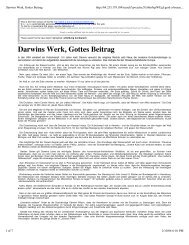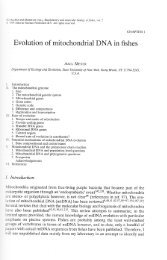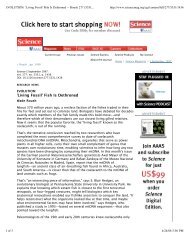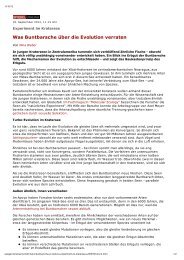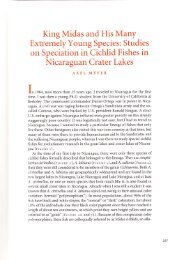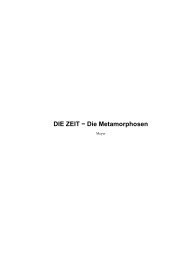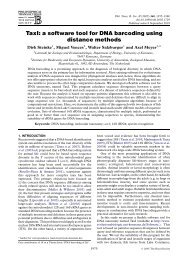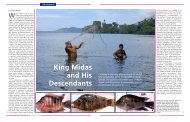Ich hab' da noch ein paar Fragen….
Ich hab' da noch ein paar Fragen….
Ich hab' da noch ein paar Fragen….
Sie wollen auch ein ePaper? Erhöhen Sie die Reichweite Ihrer Titel.
YUMPU macht aus Druck-PDFs automatisch weboptimierte ePaper, die Google liebt.
Evo-Tutorium<br />
Introduction & natural<br />
selection - 04.11.04<br />
Population genetics &<br />
A<strong>da</strong>ption - 18.11.04<br />
Classification &<br />
Phylogenetic theory -<br />
02.12.04<br />
Speciation & Species<br />
concepts - 16.12.04<br />
Sexual selection & mating<br />
systems - 13.01.05<br />
Evo-Devo & Gene<br />
duplication - 27.01.05<br />
Genomic evolution &<br />
molecular evolution -<br />
10.02.05<br />
<strong>Ich</strong> hab‘ <strong>da</strong> <strong>noch</strong> <strong>ein</strong> <strong>paar</strong> <strong>Fragen…</strong>.<br />
• Was sind<br />
– Apomorphien?<br />
– Synapomorphien?<br />
– Plesiomorphien?<br />
• Was von diesen ist informativ für <strong>ein</strong>e<br />
phylogenetische Analyse? Warum?<br />
• Was versteht man unter „Parsimony“?<br />
• Zu welcher Säugetiergruppe gehören Spitzmäuse?<br />
Evolutionstutorium 2004/05
Evo-Tutorium<br />
Introduction & natural<br />
selection - 04.11.04<br />
Population genetics &<br />
A<strong>da</strong>ption - 18.11.04<br />
Classification &<br />
Phylogenetic theory -<br />
02.12.04<br />
Speciation & Species<br />
concepts - 16.12.04<br />
Sexual selection & mating<br />
systems - 13.01.05<br />
Evo-Devo & Gene<br />
duplication - 27.01.05<br />
Genomic evolution &<br />
molecular evolution -<br />
10.02.05<br />
Klassifizierung und Evolution<br />
Klassifizierung<br />
Taxonomy<br />
≠<br />
Evolutionstutorium 2004/05<br />
Phylogenie<br />
Systematik<br />
Einordnen Wahre Phylogenetisch<br />
Verhältnisse<br />
Verwandschaftsbeziehungen
Evo-Tutorium<br />
Introduction & natural<br />
selection - 04.11.04<br />
Population genetics &<br />
A<strong>da</strong>ption - 18.11.04<br />
Classification &<br />
Phylogenetic theory -<br />
02.12.04<br />
Speciation & Species<br />
concepts - 16.12.04<br />
Sexual selection & mating<br />
systems - 13.01.05<br />
Evo-Devo & Gene<br />
duplication - 27.01.05<br />
Genomic evolution &<br />
molecular evolution -<br />
10.02.05<br />
Systematik<br />
• Individuelle Organismen werden in die niedrigsten<br />
Kategorien platziert --> Arten<br />
• Dann werden die Arten in hierarchisch höhere<br />
Einheiten (Klassen) geordnet --> Klassifizierung<br />
• Ableiten von phylogenetischen Beziehungen, der<br />
Geschichte von Organismen und deren Merkmale<br />
--> Geschichte von Verzweigungen, Evolution von<br />
Merkmalen, Biogeographie<br />
Evolutionstutorium 2004/05
Evo-Tutorium<br />
Introduction & natural<br />
selection - 04.11.04<br />
Population genetics &<br />
A<strong>da</strong>ption - 18.11.04<br />
Classification &<br />
Phylogenetic theory -<br />
02.12.04<br />
Speciation & Species<br />
concepts - 16.12.04<br />
Sexual selection & mating<br />
systems - 13.01.05<br />
Evo-Devo & Gene<br />
duplication - 27.01.05<br />
Genomic evolution &<br />
molecular evolution -<br />
10.02.05<br />
Warum muss <strong>da</strong>s s<strong>ein</strong>?<br />
• Organismen-Namen sind wichtig um sich zu<br />
verständigen<br />
• Einteilung von Organismen in Einheiten ermöglicht<br />
die Erstellung <strong>ein</strong>es Index --> Artenschutz<br />
• Taxonomie hat k<strong>ein</strong>e spezielle Verbindung mit<br />
Evolutionsbiologie<br />
Evolutionstutorium 2004/05
Evo-Tutorium<br />
Introduction & natural<br />
selection - 04.11.04<br />
Population genetics &<br />
A<strong>da</strong>ption - 18.11.04<br />
Classification &<br />
Phylogenetic theory -<br />
02.12.04<br />
Speciation & Species<br />
concepts - 16.12.04<br />
Sexual selection & mating<br />
systems - 13.01.05<br />
Evo-Devo & Gene<br />
duplication - 27.01.05<br />
Genomic evolution &<br />
molecular evolution -<br />
10.02.05<br />
Biologische Klassifikation<br />
• > 1 Million rezente Tier- und Pflanzenarten<br />
• > 1/4 Million ausgestorbene fossile Arten<br />
• Klassifikationen werden hauptsächlich von<br />
Museumsleuten aufgestellt<br />
• Lumpers splitters<br />
Oberhalb des Artniveaus sind die Einteilungen<br />
willkürlich, nur Arten sind echt.<br />
Versuch von Artdefinitionen mittels DNA-Sequenz<br />
Ähnlichkeit (funktioniert nicht)<br />
Evolutionstutorium 2004/05
Evo-Tutorium<br />
Introduction & natural<br />
selection - 04.11.04<br />
Population genetics &<br />
A<strong>da</strong>ption - 18.11.04<br />
Classification &<br />
Phylogenetic theory -<br />
02.12.04<br />
Speciation & Species<br />
concepts - 16.12.04<br />
Sexual selection & mating<br />
systems - 13.01.05<br />
Evo-Devo & Gene<br />
duplication - 27.01.05<br />
Genomic evolution &<br />
molecular evolution -<br />
10.02.05<br />
Kingdom<br />
Phyla<br />
Linné: Systema naturae (binominale<br />
Nomenklatur)<br />
Subphylum<br />
Class<br />
Order<br />
Family<br />
Genus<br />
Species<br />
Reich<br />
Stamm<br />
Unterstamm<br />
Klasse<br />
Ordnung<br />
Familie<br />
Gattung<br />
Art<br />
Evolutionstutorium 2004/05<br />
Animalia<br />
Chor<strong>da</strong>ta<br />
Vertebrata<br />
Mammalia<br />
Carnivora<br />
Cani<strong>da</strong>e<br />
Canis<br />
Canis familiaris
Evo-Tutorium<br />
Introduction & natural<br />
selection - 04.11.04<br />
Population genetics &<br />
A<strong>da</strong>ption - 18.11.04<br />
Classification &<br />
Phylogenetic theory -<br />
02.12.04<br />
Speciation & Species<br />
concepts - 16.12.04<br />
Sexual selection & mating<br />
systems - 13.01.05<br />
Evo-Devo & Gene<br />
duplication - 27.01.05<br />
Genomic evolution &<br />
molecular evolution -<br />
10.02.05<br />
Unterschiedliche Klassifikationen<br />
Phenetische Klassifikation<br />
• Gruppierungen erfolgen<br />
aufgrund von<br />
Ähnlichkeiten<br />
• Es werden k<strong>ein</strong>e<br />
Informationen über die<br />
Evolution benötigt<br />
• Hennig<br />
Evolutionstutorium 2004/05<br />
Phylogenetische Klassifikation<br />
• Gruppierungen erfolgen<br />
<strong>da</strong>nach wie weit der letzte<br />
gem<strong>ein</strong>same Vorfahre<br />
zurück liegt.<br />
• Das phylogenetische Prinzip<br />
ist die Evolution<br />
• Wichtige Namen: Sokal,<br />
Sneath
Evo-Tutorium<br />
Introduction & natural<br />
selection - 04.11.04<br />
Population genetics &<br />
A<strong>da</strong>ption - 18.11.04<br />
Classification &<br />
Phylogenetic theory -<br />
02.12.04<br />
Speciation & Species<br />
concepts - 16.12.04<br />
Sexual selection & mating<br />
systems - 13.01.05<br />
Evo-Devo & Gene<br />
duplication - 27.01.05<br />
Genomic evolution &<br />
molecular evolution -<br />
10.02.05<br />
Interner Knoten<br />
(hypothetische Vorfahre)<br />
interner Ast<br />
Wurzel<br />
Kl<strong>ein</strong>e Einführung in “Bäume”<br />
terminaler Ast<br />
Maus<br />
Mensch<br />
Vogel<br />
Frosch<br />
Fisch<br />
Hai<br />
“gewurzelter Baum”<br />
(rooted tree)<br />
Rochen<br />
Evolutionstutorium 2004/05<br />
Fisch<br />
Frosch<br />
terminaler Knoten<br />
(Taxon)<br />
Vogel<br />
Hai<br />
Mensch<br />
Rochen<br />
Maus<br />
“ungewurzelter Baum”<br />
(unrooted tree)
Evo-Tutorium<br />
Introduction & natural<br />
selection - 04.11.04<br />
Population genetics &<br />
A<strong>da</strong>ption - 18.11.04<br />
Classification &<br />
Phylogenetic theory -<br />
02.12.04<br />
Speciation & Species<br />
concepts - 16.12.04<br />
Sexual selection & mating<br />
systems - 13.01.05<br />
Evo-Devo & Gene<br />
duplication - 27.01.05<br />
Genomic evolution &<br />
molecular evolution -<br />
10.02.05<br />
Kl<strong>ein</strong>e Einführung in “Bäume”<br />
Maus<br />
Mensch<br />
Vogel<br />
Frosch<br />
Fisch<br />
Hai<br />
“gewurzelter Baum”<br />
(rooted tree)<br />
Rochen<br />
Evolutionstutorium 2004/05<br />
Fisch<br />
Frosch<br />
Vogel<br />
Schwestergruppe<br />
Hai<br />
Mensch<br />
Rochen<br />
Maus<br />
“ungewurzelter Baum”<br />
(unrooted tree)
Evo-Tutorium<br />
Introduction & natural<br />
selection - 04.11.04<br />
Population genetics &<br />
A<strong>da</strong>ption - 18.11.04<br />
Classification &<br />
Phylogenetic theory -<br />
02.12.04<br />
Speciation & Species<br />
concepts - 16.12.04<br />
Sexual selection & mating<br />
systems - 13.01.05<br />
Evo-Devo & Gene<br />
duplication - 27.01.05<br />
Genomic evolution &<br />
molecular evolution -<br />
10.02.05<br />
Kl<strong>ein</strong>e Einführung in “Bäume”<br />
Maus<br />
Mensch<br />
Vogel<br />
Frosch<br />
Fisch<br />
Hai<br />
“gewurzelter Baum”<br />
(rooted tree)<br />
Rochen<br />
Evolutionstutorium 2004/05<br />
Mammalia<br />
monophyletische<br />
GruppeFisch<br />
Frosch<br />
“Pisces”<br />
paraphyletische<br />
Gruppe<br />
Vogel<br />
Hai<br />
Mensch<br />
Rochen<br />
Maus<br />
“ungewurzelter Baum”<br />
(unrooted tree)<br />
Polyphyletische Gruppe: Gruppierung, die k<strong>ein</strong>en gem<strong>ein</strong>samen Vorfahren haben.<br />
z.B. Baumfrösche
Evo-Tutorium<br />
Introduction & natural<br />
selection - 04.11.04<br />
Population genetics &<br />
A<strong>da</strong>ption - 18.11.04<br />
Classification &<br />
Phylogenetic theory -<br />
02.12.04<br />
Speciation & Species<br />
concepts - 16.12.04<br />
Sexual selection & mating<br />
systems - 13.01.05<br />
Evo-Devo & Gene<br />
duplication - 27.01.05<br />
Genomic evolution &<br />
molecular evolution -<br />
10.02.05<br />
Wie liest man <strong>ein</strong>en Baum?<br />
G F E D C B A<br />
Neunauge Hai Fisch Frosch Vogel Maus Mensch<br />
Topologie: die Folge von Verzweigungen <strong>ein</strong>es Baumes.<br />
Evolutionstutorium 2004/05<br />
Grosse a<strong>da</strong>ptive<br />
Veränderung<br />
(z.B. Fortpflanzung<br />
nicht mehr Wasserabhängig)<br />
jetzt<br />
Zeit<br />
vor langer<br />
Zeit<br />
Verschiedene Datentypen können verschiedene Einteilungen vorgeben:<br />
1. DNA-Ähnlichkeit: (AB)(CDEFG)<br />
2. A<strong>da</strong>ptiver Veränderung: (ABC)(DEFG)<br />
3. Zeit seit dem letzten gem<strong>ein</strong>samen Vorfahren: ((((((A,B)C)D)E)F)G)
Evo-Tutorium<br />
Introduction & natural<br />
selection - 04.11.04<br />
Population genetics &<br />
A<strong>da</strong>ption - 18.11.04<br />
Classification &<br />
Phylogenetic theory -<br />
02.12.04<br />
Speciation & Species<br />
concepts - 16.12.04<br />
Sexual selection & mating<br />
systems - 13.01.05<br />
Evo-Devo & Gene<br />
duplication - 27.01.05<br />
Genomic evolution &<br />
molecular evolution -<br />
10.02.05<br />
Annahmen über Evolution<br />
• Die Aufspaltungen von <strong>ein</strong>zelnen Linien erfolgt in<br />
vernachlässigbar kurzen Zeiträumen, <strong>da</strong>her werden<br />
Knoten „punktförmig“ <strong>da</strong>rgestellt.<br />
• Die Veränderungen der Merkmale erfolgen entlang<br />
der Äste des Baumes.<br />
• Die Wurzel verbindet den betrachteten Ausschnitt<br />
mit dem „Baum des Lebens“<br />
• http://phylogeny.arizona.edu/tree/phylogeny.html<br />
Evolutionstutorium 2004/05
Evo-Tutorium<br />
Introduction & natural<br />
selection - 04.11.04<br />
Population genetics &<br />
A<strong>da</strong>ption - 18.11.04<br />
Classification &<br />
Phylogenetic theory -<br />
02.12.04<br />
Speciation & Species<br />
concepts - 16.12.04<br />
Sexual selection & mating<br />
systems - 13.01.05<br />
Evo-Devo & Gene<br />
duplication - 27.01.05<br />
Genomic evolution &<br />
molecular evolution -<br />
10.02.05<br />
Phenetische vs. phylogenetische<br />
Klassifikation<br />
• Stimmt in vielen Fällen über<strong>ein</strong>.<br />
• Aber in anderen Fällen nicht:<br />
– Vögel, Krokodile und Eidechsen<br />
– Seepocken, Hummer und Mollusken<br />
Evolutionstutorium 2004/05
Evo-Tutorium<br />
Introduction & natural<br />
selection - 04.11.04<br />
Population genetics &<br />
A<strong>da</strong>ption - 18.11.04<br />
Classification &<br />
Phylogenetic theory -<br />
02.12.04<br />
Speciation & Species<br />
concepts - 16.12.04<br />
Sexual selection & mating<br />
systems - 13.01.05<br />
Evo-Devo & Gene<br />
duplication - 27.01.05<br />
Genomic evolution &<br />
molecular evolution -<br />
10.02.05<br />
Probleme mit phenetischer Klassifikation<br />
• Konvergente Evolution: Seepocken und Mollusken<br />
– Merkmal entstehen wegen ähnlicher Lebensweise<br />
• Schnelle Evolution <strong>ein</strong>er Gruppe: Vögel<br />
– Viele Veränderungen finden in <strong>ein</strong>er Gruppe statt,<br />
d.h. die anderen Gruppen haben mehr gem<strong>ein</strong>same<br />
Merkmal<br />
Evolutionstutorium 2004/05
Evo-Tutorium<br />
Introduction & natural<br />
selection - 04.11.04<br />
Population genetics &<br />
A<strong>da</strong>ption - 18.11.04<br />
Classification &<br />
Phylogenetic theory -<br />
02.12.04<br />
Speciation & Species<br />
concepts - 16.12.04<br />
Sexual selection & mating<br />
systems - 13.01.05<br />
Evo-Devo & Gene<br />
duplication - 27.01.05<br />
Genomic evolution &<br />
molecular evolution -<br />
10.02.05<br />
3. Möglichkeit: Evolutive Klassifikation<br />
• Wichtige Namen: Mayr, Simpson, Dobzhansky<br />
• Synthese aus phenetischer und phylogenetischer<br />
Klassifizierung<br />
• Unterscheidet zwischen Konvergenz und Homologie<br />
Evolutionstutorium 2004/05
Evo-Tutorium<br />
Introduction & natural<br />
selection - 04.11.04<br />
Population genetics &<br />
A<strong>da</strong>ption - 18.11.04<br />
Classification &<br />
Phylogenetic theory -<br />
02.12.04<br />
Speciation & Species<br />
concepts - 16.12.04<br />
Sexual selection & mating<br />
systems - 13.01.05<br />
Evo-Devo & Gene<br />
duplication - 27.01.05<br />
Genomic evolution &<br />
molecular evolution -<br />
10.02.05<br />
Und <strong>noch</strong> <strong>ein</strong>ige Definitionen:<br />
• Synapomorphien: gem<strong>ein</strong>same, abgeleitete<br />
Merkmale<br />
• Autapomorphien: Merkmale die nur in <strong>ein</strong>em<br />
Organismus entstanden sind.<br />
• Plesiomorphien: Ursprüngliche Merkmale<br />
Evolutionstutorium 2004/05
Evo-Tutorium<br />
Introduction & natural<br />
selection - 04.11.04<br />
Population genetics &<br />
A<strong>da</strong>ption - 18.11.04<br />
Classification &<br />
Phylogenetic theory -<br />
02.12.04<br />
Speciation & Species<br />
concepts - 16.12.04<br />
Sexual selection & mating<br />
systems - 13.01.05<br />
Evo-Devo & Gene<br />
duplication - 27.01.05<br />
Genomic evolution &<br />
molecular evolution -<br />
10.02.05<br />
Evolution<br />
• Def: Abstammung mit Modifikationen (Darwin)<br />
– --> es entsteht <strong>ein</strong>e Geschichte von Veränderungen<br />
• Populationen werden getrennt, und <strong>da</strong> bei<br />
entstehen neue Linien<br />
• Das Resultat ist <strong>ein</strong>e baumartige, hierarchische<br />
Strukur der Verwandtschaftsbeziehungen<br />
zwischen Organismen: Phylogenie (Haeckel)<br />
Evolutionstutorium 2004/05
Evo-Tutorium<br />
Introduction & natural<br />
selection - 04.11.04<br />
Population genetics &<br />
A<strong>da</strong>ption - 18.11.04<br />
Classification &<br />
Phylogenetic theory -<br />
02.12.04<br />
Speciation & Species<br />
concepts - 16.12.04<br />
Sexual selection & mating<br />
systems - 13.01.05<br />
Evo-Devo & Gene<br />
duplication - 27.01.05<br />
Genomic evolution &<br />
molecular evolution -<br />
10.02.05<br />
Phylogenetische Forschung:<br />
Was machen die eigentlich?<br />
• Rekonstruktion der Evolution<br />
• Heute hauptsächlich über DNA Sequenzen, zuerst<br />
über morphologische Merkmale, wobei dort<br />
Fossilien mit <strong>ein</strong>bezogen werden<br />
• Problem: Wie können wir Aussagen über die<br />
Vergangenheit machen?<br />
--> Man betrachtet die Verteilung von Merkmale<br />
zwischen verschiedenen Taxa<br />
--> Taxa die von <strong>ein</strong>em gem<strong>ein</strong>samen Vorfahren<br />
abstammen sollten gem<strong>ein</strong>same Merkmale haben<br />
--> Gruppierungen nach gem<strong>ein</strong>samen Merkmalen sollte<br />
<strong>da</strong>her zu monophyletischen Gruppen führen.<br />
Evolutionstutorium 2004/05
Evo-Tutorium<br />
Introduction & natural<br />
selection - 04.11.04<br />
Population genetics &<br />
A<strong>da</strong>ption - 18.11.04<br />
Classification &<br />
Phylogenetic theory -<br />
02.12.04<br />
Speciation & Species<br />
concepts - 16.12.04<br />
Sexual selection & mating<br />
systems - 13.01.05<br />
Evo-Devo & Gene<br />
duplication - 27.01.05<br />
Genomic evolution &<br />
molecular evolution -<br />
10.02.05<br />
Beispiel<br />
• Die Wahl der Merkmale spielt <strong>ein</strong>e große Rolle<br />
– z.B. : Fehlen von Körperbehaarung ist <strong>ein</strong>e<br />
Autapomorphie von Menschen<br />
– Das führt zu dem Schluss, <strong>da</strong>ss die Affen<br />
monophyletisch sind<br />
– Wichtig: Berücksichtigung <strong>ein</strong>er Außengruppe:<br />
Behaarung ist <strong>ein</strong>e Plesiomorphie (Ursprüngliche<br />
Zustand), kann deshalb k<strong>ein</strong>e Gruppe definieren.<br />
(Cladistische Methode)<br />
• Weiteres Beispiel: Penta<strong>da</strong>ctylie<br />
Evolutionstutorium 2004/05
Evo-Tutorium<br />
Introduction & natural<br />
selection - 04.11.04<br />
Population genetics &<br />
A<strong>da</strong>ption - 18.11.04<br />
Classification &<br />
Phylogenetic theory -<br />
02.12.04<br />
Speciation & Species<br />
concepts - 16.12.04<br />
Sexual selection & mating<br />
systems - 13.01.05<br />
Evo-Devo & Gene<br />
duplication - 27.01.05<br />
Genomic evolution &<br />
molecular evolution -<br />
10.02.05<br />
Prinzip der Cladistik<br />
• Ursprüngliche, „primitive“ oder plesiomorphischen<br />
Merkmalen (Plesiomorphien)<br />
– K<strong>ein</strong> Beweis für <strong>ein</strong>en gem<strong>ein</strong>samen Vorfahren<br />
• Abgeleitete oder apomorhische Merkmale<br />
(Apomorphien)<br />
– Falls mehrere terminale Taxa die gleiche Apomophie<br />
teilen (Synapomorphie), ist <strong>da</strong>s <strong>ein</strong> Beweis für deren<br />
gem<strong>ein</strong>same Herkunft.<br />
– Falls <strong>ein</strong> <strong>ein</strong>zelnes terminales Taxon <strong>ein</strong> <strong>ein</strong>zigartiges,<br />
abgeleitetes Merkmal hat (Autapomorphie), trägt<br />
dies nicht zu dem Beweis für phylogenetische<br />
Verhältnisse bei.<br />
Evolutionstutorium 2004/05
Evo-Tutorium<br />
Introduction & natural<br />
selection - 04.11.04<br />
Population genetics &<br />
A<strong>da</strong>ption - 18.11.04<br />
Classification &<br />
Phylogenetic theory -<br />
02.12.04<br />
Speciation & Species<br />
concepts - 16.12.04<br />
Sexual selection & mating<br />
systems - 13.01.05<br />
Evo-Devo & Gene<br />
duplication - 27.01.05<br />
Genomic evolution &<br />
molecular evolution -<br />
10.02.05<br />
Nächstes Problem:<br />
Welches Mermal ist ursprünglich?<br />
1. Zuerst werden die Verwandschaftsverhältnisse<br />
ermittelt (ohne Zeitkomponente)<br />
--> Baum ohne Wurzel, von allen Möglichkeiten wird<br />
der Baum gewählt der am wenigsten Schritte<br />
benötig (Parsimony = Sparsamkeit)<br />
2. Der Ast, der die Wurzel enthält, wird ermittelt<br />
--> z.B. mittels <strong>ein</strong>er Außengruppe<br />
--> Die Wurzel ist der Ast der die Innengruppe mit<br />
der Außengruppe verbindet.<br />
Evolutionstutorium 2004/05
Evo-Tutorium<br />
Introduction & natural<br />
selection - 04.11.04<br />
Population genetics &<br />
A<strong>da</strong>ption - 18.11.04<br />
Classification &<br />
Phylogenetic theory -<br />
02.12.04<br />
Speciation & Species<br />
concepts - 16.12.04<br />
Sexual selection & mating<br />
systems - 13.01.05<br />
Evo-Devo & Gene<br />
duplication - 27.01.05<br />
Genomic evolution &<br />
molecular evolution -<br />
10.02.05<br />
Die Vergleichende Methode<br />
• Vergleiche zwischen Arten werden <strong>da</strong>zu genutzt,<br />
generell Schlüsse über Evolution zu ziehen.<br />
– z.B. Pulsrate und Körpergröße in Säugetieren<br />
– Hier Problem der Phylogenie: wenn man zwei Mäuse<br />
mit zwei Walen vergleicht, kann der Unterschied aus<br />
unzählige Möglichkeiten entstehen: Umgebung,<br />
Lebensspanne, …<br />
• 1. Unabhängiger Kontrast: Schwestergruppen<br />
werden zusätzlich verglichen<br />
• 2. Direkte Rekonstruktion von evolutiven<br />
Veränderungen: Erfordert die Rekonstruktion aller<br />
vorausgegangenen Stadien.<br />
Evolutionstutorium 2004/05
Evo-Tutorium<br />
Introduction & natural<br />
selection - 04.11.04<br />
Population genetics &<br />
A<strong>da</strong>ption - 18.11.04<br />
Classification &<br />
Phylogenetic theory -<br />
02.12.04<br />
Speciation & Species<br />
concepts - 16.12.04<br />
Sexual selection & mating<br />
systems - 13.01.05<br />
Evo-Devo & Gene<br />
duplication - 27.01.05<br />
Genomic evolution &<br />
molecular evolution -<br />
10.02.05<br />
Beispiele<br />
• Notothenii<strong>da</strong>e (Antarktische Fische)<br />
– Zwei Formen: Im Pelagial oder am Grund lebend<br />
– Hypothese: Vorfahre lebte am Grund.<br />
– Phylogenie wird anhand von morphologische<br />
Merkmalen erstellt<br />
– Außengruppe: aaaah, <strong>ein</strong> am Grund lebender Fisch<br />
(wie überraschend)<br />
– Man arbeitet sich von den Spitzen beginnend<br />
hinunter und kann <strong>ein</strong>zelne Merkmale <strong>ein</strong>zelnen Ästen<br />
zuordnen.<br />
Evolutionstutorium 2004/05
Evo-Tutorium<br />
Introduction & natural<br />
selection - 04.11.04<br />
Population genetics &<br />
A<strong>da</strong>ption - 18.11.04<br />
Classification &<br />
Phylogenetic theory -<br />
02.12.04<br />
Speciation & Species<br />
concepts - 16.12.04<br />
Sexual selection & mating<br />
systems - 13.01.05<br />
Evo-Devo & Gene<br />
duplication - 27.01.05<br />
Genomic evolution &<br />
molecular evolution -<br />
10.02.05<br />
Anderes Beispiel: Schwertträger<br />
• Erstellung <strong>ein</strong>er molekularen Phylogenie<br />
• Anhand der erhaltenen Topologie kann entschieden<br />
werden wie oft Schwerter unabhängig von <strong>ein</strong>ander<br />
entstanden sind.<br />
• Was war früher? Die Vorliebe der Weibchen für<br />
Männchen mit Schwertern oder die Schwerter?<br />
Evolutionstutorium 2004/05
Evo-Tutorium<br />
Introduction & natural<br />
selection - 04.11.04<br />
Population genetics &<br />
A<strong>da</strong>ption - 18.11.04<br />
Classification &<br />
Phylogenetic theory -<br />
02.12.04<br />
Speciation & Species<br />
concepts - 16.12.04<br />
Sexual selection & mating<br />
systems - 13.01.05<br />
Evo-Devo & Gene<br />
duplication - 27.01.05<br />
Genomic evolution &<br />
molecular evolution -<br />
10.02.05<br />
Beispiel Echsen mit „Toe-pads“<br />
• Sind dreimal innerhalb der Echsen unabhängig von<br />
<strong>ein</strong>ander entstanden<br />
• Die Fähigkeit an glatten Untergründen<br />
festzuhalten hat die gleiche Verteilung<br />
• Alle drei Ursprünge sind innerhalb von Gruppen von<br />
baumbewohnenden Echsen.<br />
• --> Zuerst war der Lebensraum und <strong>da</strong>nn <strong>da</strong>s<br />
Merkmal --> A<strong>da</strong>ptation<br />
Evolutionstutorium 2004/05
Evo-Tutorium<br />
Introduction & natural<br />
selection - 04.11.04<br />
Population genetics &<br />
A<strong>da</strong>ption - 18.11.04<br />
Classification &<br />
Phylogenetic theory -<br />
02.12.04<br />
Speciation & Species<br />
concepts - 16.12.04<br />
Sexual selection & mating<br />
systems - 13.01.05<br />
Evo-Devo & Gene<br />
duplication - 27.01.05<br />
Genomic evolution &<br />
molecular evolution -<br />
10.02.05<br />
Homolog vs Analog<br />
• Erste Definition von Homologie, Richard Owen<br />
1843<br />
• Homologie: <strong>da</strong>s gleiche Organ in jeglicher Form und<br />
Funktion (wirkliche oder prinzipielle Entsprechung)<br />
• Analogie: oberflächliche oder fehlleitende<br />
Ähnlichkeit<br />
• Definition enthält <strong>noch</strong> k<strong>ein</strong>e Evolution!!!<br />
• Darwin: Ähnlichkeit die aus der Abstammung von<br />
<strong>ein</strong>em gem<strong>ein</strong>samen Vorfahren her stammt, die<br />
Identifikation und Analyse von Homologien ist <strong>ein</strong><br />
zentraler Punkt der Phylogenetischen Systematik<br />
Evolutionstutorium 2004/05
Evo-Tutorium<br />
Introduction & natural<br />
selection - 04.11.04<br />
Population genetics &<br />
A<strong>da</strong>ption - 18.11.04<br />
Classification &<br />
Phylogenetic theory -<br />
02.12.04<br />
Speciation & Species<br />
concepts - 16.12.04<br />
Sexual selection & mating<br />
systems - 13.01.05<br />
Evo-Devo & Gene<br />
duplication - 27.01.05<br />
Genomic evolution &<br />
molecular evolution -<br />
10.02.05<br />
• Ortolog: Verschiedene<br />
Sequenzen durch<br />
Artbildung<br />
• Paralog: Verschiedene<br />
Sequenzen durch<br />
Genduplikation<br />
Bei Genen<br />
Evolutionstutorium 2004/05
Evo-Tutorium<br />
Introduction & natural<br />
selection - 04.11.04<br />
Population genetics &<br />
A<strong>da</strong>ption - 18.11.04<br />
Classification &<br />
Phylogenetic theory -<br />
02.12.04<br />
Speciation & Species<br />
concepts - 16.12.04<br />
Sexual selection & mating<br />
systems - 13.01.05<br />
Evo-Devo & Gene<br />
duplication - 27.01.05<br />
Genomic evolution &<br />
molecular evolution -<br />
10.02.05<br />
Wie schaut <strong>da</strong>s normalerweise aus?<br />
Duplikation<br />
0.1<br />
Takifugu rubripes a<br />
Evolutionstutorium 2004/05<br />
Gasterosteus aculeatus a<br />
Oncorhynchus mykiss a<br />
Danio rerio a<br />
Gasterosteus aculeatus b<br />
Oryzias latipes b<br />
Takifugu rubripes b<br />
Danio rerio b<br />
Mus musculus<br />
Homo sapiens<br />
Gallus gallus<br />
Xenopus laevis<br />
Outgroup<br />
Kopie a<br />
Kopie b<br />
Tetrapoden
Evo-Tutorium<br />
Introduction & natural<br />
selection - 04.11.04<br />
Population genetics &<br />
A<strong>da</strong>ption - 18.11.04<br />
Classification &<br />
Phylogenetic theory -<br />
02.12.04<br />
Speciation & Species<br />
concepts - 16.12.04<br />
Sexual selection & mating<br />
systems - 13.01.05<br />
Evo-Devo & Gene<br />
duplication - 27.01.05<br />
Genomic evolution &<br />
molecular evolution -<br />
10.02.05<br />
Duplikation<br />
0.1<br />
Takifugu rubripes a<br />
Evolutionstutorium 2004/05<br />
Gasterosteus aculeatus a<br />
Oncorhynchus mykiss a<br />
Danio rerio a<br />
Gasterosteus aculeatus b<br />
Oryzias latipes b<br />
Takifugu rubripes b<br />
Danio rerio b<br />
Mus musculus<br />
Homo sapiens<br />
Gallus gallus<br />
Xenopus laevis<br />
Outgroup<br />
Paraloge<br />
Tetrapoden
Evo-Tutorium<br />
Introduction & natural<br />
selection - 04.11.04<br />
Population genetics &<br />
A<strong>da</strong>ption - 18.11.04<br />
Classification &<br />
Phylogenetic theory -<br />
02.12.04<br />
Speciation & Species<br />
concepts - 16.12.04<br />
Sexual selection & mating<br />
systems - 13.01.05<br />
Evo-Devo & Gene<br />
duplication - 27.01.05<br />
Genomic evolution &<br />
molecular evolution -<br />
10.02.05<br />
Duplikation<br />
0.1<br />
Takifugu rubripes a<br />
Evolutionstutorium 2004/05<br />
Gasterosteus aculeatus a<br />
Oncorhynchus mykiss a<br />
Danio rerio a<br />
Gasterosteus aculeatus b<br />
Oryzias latipes b<br />
Takifugu rubripes b<br />
Danio rerio b<br />
Mus musculus<br />
Homo sapiens<br />
Gallus gallus<br />
Xenopus laevis<br />
Tetrapoden<br />
Outgroup<br />
Orthologe
Evo-Tutorium<br />
Introduction & natural<br />
selection - 04.11.04<br />
Population genetics &<br />
A<strong>da</strong>ption - 18.11.04<br />
Classification &<br />
Phylogenetic theory -<br />
02.12.04<br />
Speciation & Species<br />
concepts - 16.12.04<br />
Sexual selection & mating<br />
systems - 13.01.05<br />
Evo-Devo & Gene<br />
duplication - 27.01.05<br />
Genomic evolution &<br />
molecular evolution -<br />
10.02.05<br />
Phenetische Rekonstruktion<br />
• Datenmatrix erstellen, Präsenz-Absenz Kodierung<br />
(1-0)<br />
• Ähnlichkeiten berechnen, Gruppierung der Gruppe<br />
mit dem höchsten Score<br />
• Neuberechnung der Ähnlichkeiten<br />
• Wiederholung bis zum Schluss<br />
Evolutionstutorium 2004/05
Evo-Tutorium<br />
Introduction & natural<br />
selection - 04.11.04<br />
Population genetics &<br />
A<strong>da</strong>ption - 18.11.04<br />
Classification &<br />
Phylogenetic theory -<br />
02.12.04<br />
Speciation & Species<br />
concepts - 16.12.04<br />
Sexual selection & mating<br />
systems - 13.01.05<br />
Evo-Devo & Gene<br />
duplication - 27.01.05<br />
Genomic evolution &<br />
molecular evolution -<br />
10.02.05<br />
Phylogenetische Rekonstruktion<br />
• Basiert auf wahren Homologien<br />
• Gruppierung von Monophyletischen Gruppen<br />
• Jedes Merkmal gibt <strong>ein</strong>e Aufspaltung<br />
• Schrittweise können die Merkmale nun auf den<br />
Baum aufgetragen werden.<br />
Evolutionstutorium 2004/05
Evo-Tutorium<br />
Introduction & natural<br />
selection - 04.11.04<br />
Population genetics &<br />
A<strong>da</strong>ption - 18.11.04<br />
Classification &<br />
Phylogenetic theory -<br />
02.12.04<br />
Speciation & Species<br />
concepts - 16.12.04<br />
Sexual selection & mating<br />
systems - 13.01.05<br />
Evo-Devo & Gene<br />
duplication - 27.01.05<br />
Genomic evolution &<br />
molecular evolution -<br />
10.02.05<br />
Darstellungen<br />
• Phylogramm:<br />
– Aufspaltungsreihenfolge (branch order)<br />
– Astlängen (branch length), Anzahl evol. Ereignisse<br />
• Kladogramm:<br />
– Nur branch order<br />
– Astlängen sind willkürlich<br />
• Aussengruppe<br />
– Zum Wurzeln der Bäume (was ist basal?)<br />
Evolutionstutorium 2004/05
Evo-Tutorium<br />
Introduction & natural<br />
selection - 04.11.04<br />
Population genetics &<br />
A<strong>da</strong>ption - 18.11.04<br />
Classification &<br />
Phylogenetic theory -<br />
02.12.04<br />
Speciation & Species<br />
concepts - 16.12.04<br />
Sexual selection & mating<br />
systems - 13.01.05<br />
Evo-Devo & Gene<br />
duplication - 27.01.05<br />
Genomic evolution &<br />
molecular evolution -<br />
10.02.05<br />
• Zuckerkandl and Pauling<br />
(1965)<br />
• Prot<strong>ein</strong>sequenzen als Daten<br />
• Später: DNA Sequenzen<br />
– Non-synonymous<br />
Substitution:<br />
Nukleoti<strong>da</strong>ustausch führt<br />
zu <strong>ein</strong>er veränderten<br />
Aminosäure-Sequenz<br />
– Synonymous Substitution:<br />
Nukleoti<strong>da</strong>ustausch wirkt<br />
sich auf Aminosäure-<br />
Sequenz nicht aus<br />
(Selektion „sieht“ nur <strong>da</strong>s<br />
Prot<strong>ein</strong>!!!!)<br />
Molekulare Evolution<br />
Evolutionstutorium 2004/05
Evo-Tutorium<br />
Introduction & natural<br />
selection - 04.11.04<br />
Population genetics &<br />
A<strong>da</strong>ption - 18.11.04<br />
Classification &<br />
Phylogenetic theory -<br />
02.12.04<br />
Speciation & Species<br />
concepts - 16.12.04<br />
Sexual selection & mating<br />
systems - 13.01.05<br />
Evo-Devo & Gene<br />
duplication - 27.01.05<br />
Genomic evolution &<br />
molecular evolution -<br />
10.02.05<br />
Es gibt auch Probleme: z.B. lange Äste<br />
• Felsenst<strong>ein</strong> Zone<br />
• A und B werden aufgrund ihrer hohen evolutiven Rate<br />
zusammen gruppiert<br />
Evolutionstutorium 2004/05
Evo-Tutorium<br />
Introduction & natural<br />
selection - 04.11.04<br />
Population genetics &<br />
A<strong>da</strong>ption - 18.11.04<br />
Classification &<br />
Phylogenetic theory -<br />
02.12.04<br />
Speciation & Species<br />
concepts - 16.12.04<br />
Sexual selection & mating<br />
systems - 13.01.05<br />
Evo-Devo & Gene<br />
duplication - 27.01.05<br />
Genomic evolution &<br />
molecular evolution -<br />
10.02.05<br />
Oder unterschiedliche Basen-Zusammensetzung<br />
Evolutionstutorium 2004/05



